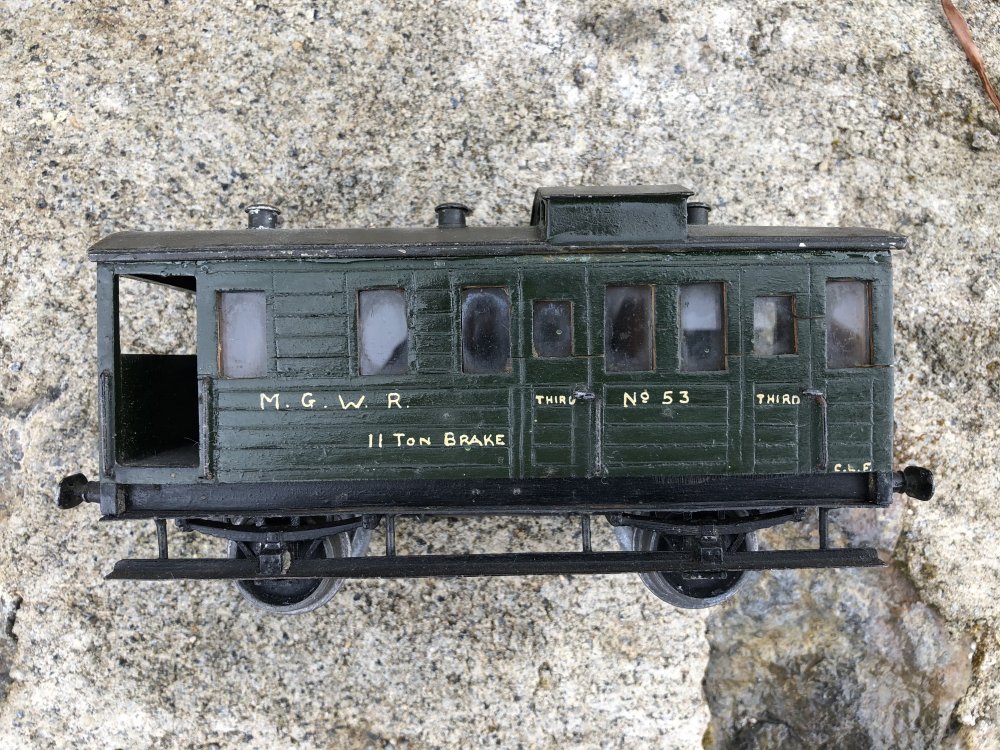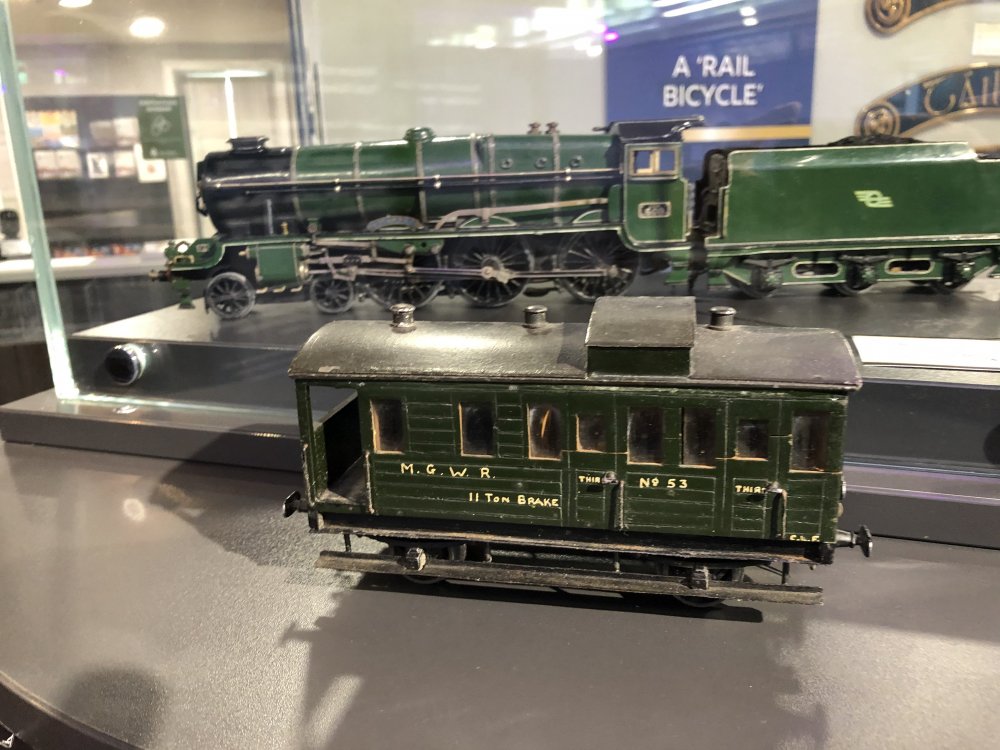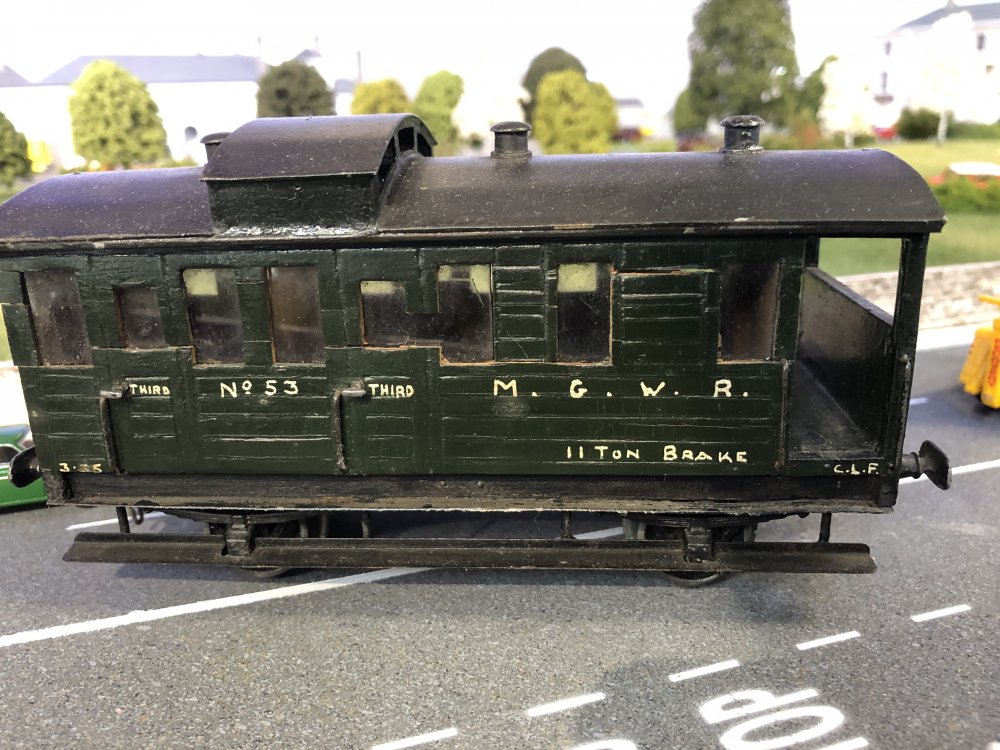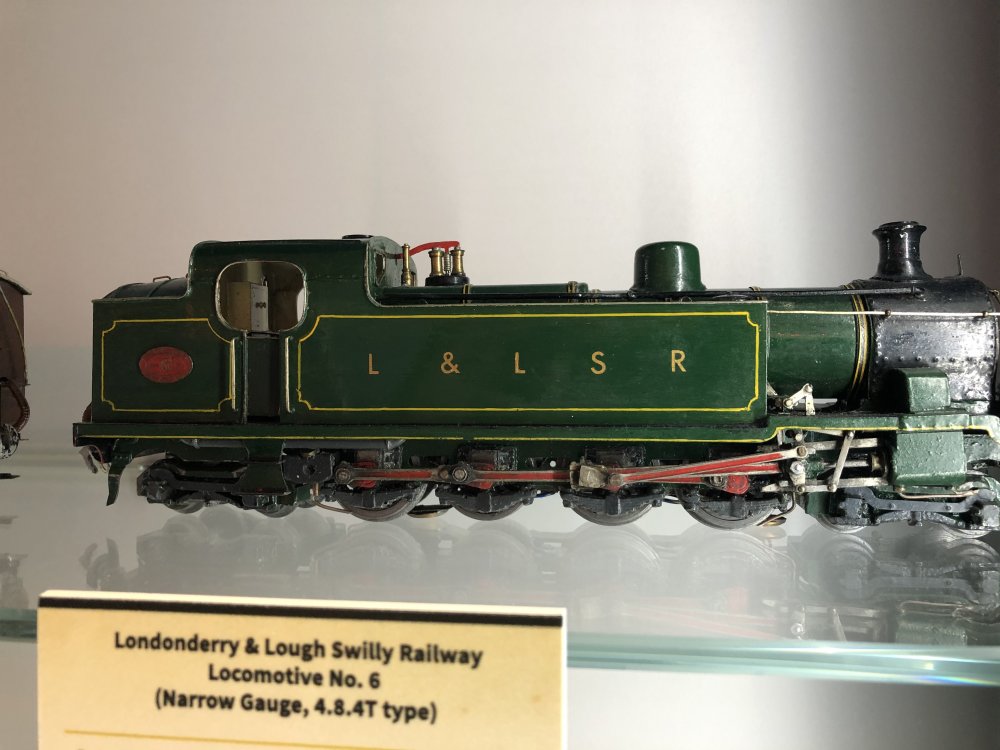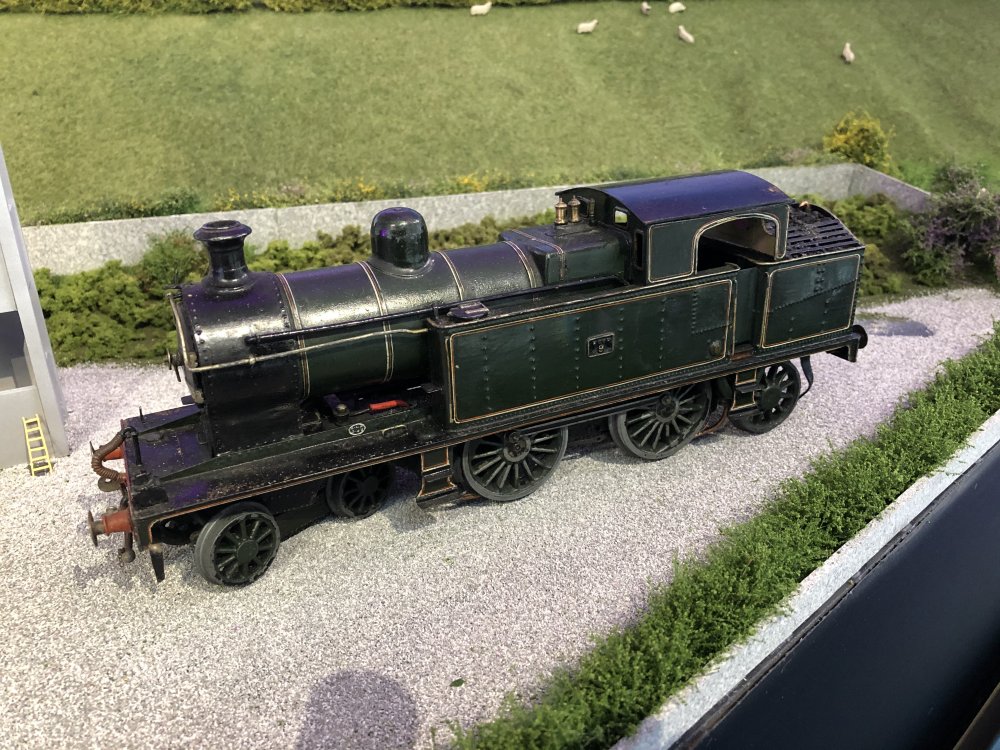-
Posts
15,935 -
Joined
-
Last visited
-
Days Won
394
Content Type
Profiles
Forums
Events
Gallery
Blogs
Community Map
Everything posted by jhb171achill
-
Loco liveries: BCDR & LLSR & MGWR brake van green
jhb171achill replied to jhb171achill's topic in Irish Models
I am not sure what Midland guards vans had the green livery, whether any that did were this shade, or as suggested in another source, something lighter (could have been this, badly faded). Fry was in Broadstone when vans like this were being painted, so I suspect the dark shade shown here is certainly how they started. This green livery was not applied to any other vehicle - only goods brake vans / drovers vans such as this. WLWR goods stock was, I believe, plain dark grey. The varnished wagons seen in Ernie's book were pre-WLWR, in W&LR days, and probably only like this on delivery. -
Malahide Casino Model Railway Museum Reopening 19th
jhb171achill replied to jhb171achill's topic in News
Perfect! Here goes, then: IMG_7921.MOV IMG_7922.MOV IMG_7923.MOV IMG_7924.MOV IMG_7926.MOV IMG_7929.MOV IMG_7930.MOV IMG_7936.MOV IMG_7937.MOV IMG_7938.MOV IMG_7943.MOV IMG_7944.MOV IMG_7946.MOV IMG_7948.MOV IMG_7949.MOV IMG_7950.MOV IMG_7951.MOV -
Malahide Casino Model Railway Museum Reopening 19th
jhb171achill replied to jhb171achill's topic in News
I took a whole pile of videos this afternoon, but none will load! I'll try this one. Someone let me know if it works. IMG_7921.MOV -
Malahide Casino Model Railway Museum Reopening 19th
jhb171achill replied to jhb171achill's topic in News
IMG_7948.MOV -
The above will reopen on 19th May. During the lockdown, further scenic work has taken place, plus a few glitches here and there worked on. More trains are operating now, and 121s have been acquired. A few shots from test operation today: Full details, times & prices from their website https://www.modelrailwaymuseum.ie/ IMG_7950.MOV IMG_7951.MOV IMG_7949.MOV Scenic aspects IMG_7944.MOV
-
Running your IRM A class with what stock
jhb171achill replied to DJ Dangerous's topic in General Chat
Not even ten or fifteen, I would be pretty certain...... most definitely not with an "A". -
In response to several enquiries, and from Cyril Fry’s models, here are the dark green colours used by the above-mentioned: The first four are what Fry had for the Midland goods brakes. However, some reports suggest a lighter colour; maybe both were used. I am unaware of any way of confirming this. Others were certainly grey, like the wagons. CIE green is shown (Maedb) as a comparison, albeit necessarily in artificial light. The County Down green is certainly accurate. It was darker than UTA green, and not remotely like No. 30 in Cultra. The LLSR green - something tells me it could have been darker (certainly not lighter) but that was possibly due to the dirt and grime which darkened its appearance in use. I include it for completeness.
-
Not sure precisely, but I'd guess about 7 or 8 years ago. In "brown" days too, the whole thing was brown - it didn't have little blue and green bits. I reckon these, plus the black, aren't a "livery" as such; just manufacturer's colours which they no longer paint brown themselves before using in traffic.
-
Running your IRM A class with what stock
jhb171achill replied to DJ Dangerous's topic in General Chat
As others have said, much of the items you'd need to run with a silver or green "A" are not commercially available, and most of those that are, would be in kit form. However, for information: To run with “A” class locos in silver and green; the two overlapped. Year OTHER LOCOS (Also AEC Railcars with ALL) PASSENGER GOODS 1955 All silver B101, steam Old wooden bogie Green Old Six-wheelers Green Bredins Green Early 1950s Bredin-like CIE Green New “Tin Vans” SILVER New Park Royals SILVER New Laminates SILVER All wagons grey prior to 1970. Flying snails on all 1956 B101, steam Same as above, but silver coaches repainted green from c.1958, and all new stock after that green instead of silver. 1957 C, B101, steam 1958 Gradually repainted green 1959 1960 1961 Grey B121 plus above 1962 Grey B121 plus above 1963 Last few silver Black livery starts (Dec 62) Steam ends; Grey B121, C, B101, B141 1. No more six-wheelers. 2. Cravens introduced. Very gradual replacement of flying snails with roundels 1964 Grey B121, C, B101, B141 Coaches gradually repainted black’n’tan from early 1963. “H” vans painted a lighter grey 1965 Last few still green B121, C, B101, B141 Last green coaches finally repainted black’n’tan c.1967 Palvans introduced, lighter grey 121 liveries - Delivered in grey 1961 - First repaints into black'n'tan circa 1964 - Last repaints into black'n'tan circa 1967 - "Supertrain" livery (no white lines) 1972 - 1987 (Last repaints out of old black'n'tan into "supertrain" approx. 1976/77 - "Tippex" white lines added from 1987 onwards - several retained older livery for several years afterwards. The final livery WITH white lines was of course, initially with the "set of points" logo, and later the "three-pin-plug" logo. -
Running your IRM A class with what stock
jhb171achill replied to DJ Dangerous's topic in General Chat
Very much so. Black bogies on anything are a comparatively recent thing: for example, you wouldn’t have them with the likes of Bell containers. -
Oxford Diecast had a few items at about £5 sterling.....I have what's supposed to be a garda van, though i don't know enough about policing vehicles to know whether it's authentic or not.......
-
Hope those gloves are day-glo.......and she has her PTS......... Child protection pass, first aid cert........
-
And no rationale as to why you shouldn't be making them? I couldn't be 100% certain on all types of vans, but the ones I remember earliest were, I think - Ford? They had a narrow cab and a radiator on the front. I'd say they were of mid-50s vintage onwards. (plus orange Ford transits in the 70s with white doors)
-
Out of curiosity, upon what perceived basis did they try to tell you this? And, again out of curiosity, and if it does not compromise privacy, were these people also in the same business? I would like to see a typical 1960s post office van. Often seen at stations picking up mail vans.
-
Oh, INDEED I can! I worked with galteemore-senior for years, and often had the conversation. Initially, we tried selling "enthusiast stuff" on trains, but the few enthusiasts on board would pick over the railway books on offer, reading them cover to cover, then sidle off to eat the sandwiches they'd brought with them. G.Senior and I started selling instant raffles and teddy bears and toy tractors to the kiddies, and the money machine was born........ The only time the RPSI sells many books is on the May tour - and who buys them, to this day? Mostly the Englishmen, who will then tell you to put the £20 change in the "kitty"! Disclaimer: There ARE notable exceptions to both, so please don't take offence if you're one of 'em!
-
100% right!
-
Yes, I would agree. It's even worse, of course, on the whole island of Ireland, where the level of interest never approaches even a fraction of that in Britain - or, specifically, England and Wales. For decades i did the seating plan for the annual RPSI May Tour, for a very long time the very biggest railway enthusiast event in Ireland, probably still so, covid-permitting. The number of participants from the WHOLE of Ireland would never, on a single occasion, have filled even one carriage. Virtually all the regulars, bar RPSI personnel and one or two notables, were English. And fair play to them; as i told many of them, many times, without them the tour would NEVER have made it even into the 1970s. Downpatrick carries in a year what the Severn Valley would in a weekend. OK, I hear all say, Ireland as a whole has less than 7 million people, whereas England alone has ten times that. Fair point - however - on a typical train on a British preserved railway, you might get 10-15% who are enthusiasts. Not here. Here, it's mummy, daddy and the kids going on the big chuff-chuff train for a day out. At Downpatrick, or on a Portrush Flyer, actual railway enthusiasts, particularly ones who have travelled a distance, are a rarity, except again for a TINY few regulars. And they're STINGY! (the few REGULARS excluded!) BOY, are Irish railway enthusiasts STINGY!!! Raffles, buying souvenirs, supporting donation tins - and I make no apology for the rant, as treasurer of both the DCDR and RPSI for some 25 years, and Commerical Officer before that - so-called "supporters" of these organisations scuttle down holes, often awkwardly counting out coins in their pockets, at the mere mention of buying a raffle ticket. But look in the bar AFTER the trip - they're all there. OK, back to Steve's point - the cultural lack of interest here, north and south, results in TV programmes with either lightweight, or carelessly inaccurate or superficial "history". The recent RTE series with Enda is par for the course, with the "narrow-gauge" Achill line illustrated by a CDR train.......and so on. I've calmed down now. I had my covid jab today. Maybe this is the side effect.......
-
Anyone in the market for some full size toys?
jhb171achill replied to irishthump's topic in General Chat
Shades of the loss-making HEI at Whitehead! -
In your second last pic, on the right there are a couple of coaches. Are those the SECR models? If so, they bear a "two-foot-rule" resemblance to the post-1903 MGWR designs. At least one ex-Midland coach did, in fact, operated briefly on the CBSCR main line immediately before the railcars came.
-
121 with white lines - thus post '87.....
-
Anyone in the market for some full size toys?
jhb171achill replied to irishthump's topic in General Chat
Sad. Travelled on it a few years ago - an amazing line. If they're up for grabs, we'd need to know if they are DC or DCC. -
Mallow, late 1980s, maybe early 90s. Tralee branch train on left.
-
Absolutely inspiring again, David! You mention the Dublin & Meath brake vans taken over by the Midland. If these are strictly passenger vans, then brown as you say - but if they are goods or mixed train vehicles, grey or possibly a dark green colour, though I am uncertain when the MGWR abandoned green for brake vans in favour of brown. If you use the green, there's a model of Fry's in Malahide with this colour. I've to call in there soon, so I'll take a pic of it. And yes, wagons inevitably got mixed up. I've seen pics of a GSWR van in Derry (Foyle Road), a DSER and a GSWR one in Achill, and a GNR one in West Cork!
-
Might be worth getting the IRRS on board for one of their "outings"? Would make a nice day out, if social distancing permits - Dublin - Central - Derry & back by train. What are the current regulations regarding travel in the north?
.png.c363cdf5c3fb7955cd92a55eb6dbbae0.png)




